Aakash Repeater Courses
ApplyTake Aakash iACST and get instant scholarship on coaching programs.
Have you ever tried to share a pizza with your friends? Congratulations, you’ve already used fractions! In the world of numbers, fractions are the art of splitting and still staying connected. We are surrounded by fractions on all our sides. Fractions are an integral part of our lives. Fractions are a part of a whole. If we share a single chocolate among two people, each person gets half of the chocolate, which is a part of a whole. This NCERT Solutions for class 6 article contains the answers to all the questions in this chapter in a comprehensive, step-by-step manner.

Fractions help us realise that even small parts can add up to something whole. These NCERT Solutions for Class 6 Maths are highly reliable resources, as they were created by experienced subject matter experts from Careers360. Students can use these solutions to practice more questions and check their answers during exam preparation to identify their weaknesses and areas for improvement later. Explore the full NCERT curriculum, along with revision notes and PDFs, at this link: NCERT.
|
Page number: 152-153 |
Fill in the blanks with fractions.
Question 1: Three guavas together weigh 1 kg. If they are roughly of the same size, each guava will roughly weigh ____ kg.
Answer:
Given, weigh of 3 guavas
then weigh of each of the guava
Question 2: A wholesale merchant packed 1 kg of rice in four packets of equal weight. The weight of each packet is ___ kg.
Answer:
1 kg of rice is packed in 4 packets of equal weight, then the weight of each packet is
Question 3: Four friends ordered 3 glasses of sugarcane juice and shared them equally among themselves. Each one drank ____ glass of sugarcane juice.
Answer:
The Amount of sugarcane consumed by four friends = 3 glasses.
Amount of sugarcane consumed by each friend
Hence, each one drank
Question 4: The big fish weighs
Answer:
Given the weighs of big fish
Total weight of both fish
Question 5: Arrange these fraction words in order of size from the smallest to the biggest in the empty box below: One and a half, three-quarters, one and a quarter, half, quarter, two and a half.
Answer:
One and a half means
Three-quarters means
One and a quarter means
Half means
Quarter means
Two and a half mean
Now, arranging the fraction words in order of size from the smallest to the biggest parts: Quarter < Half < Three Quarters < One and a quarter < One and a half < Two and a half.
|
Page number: 55 |
Question 1: The figures below show different fractional units of a whole chikki. How much of a whole chikki is each piece?
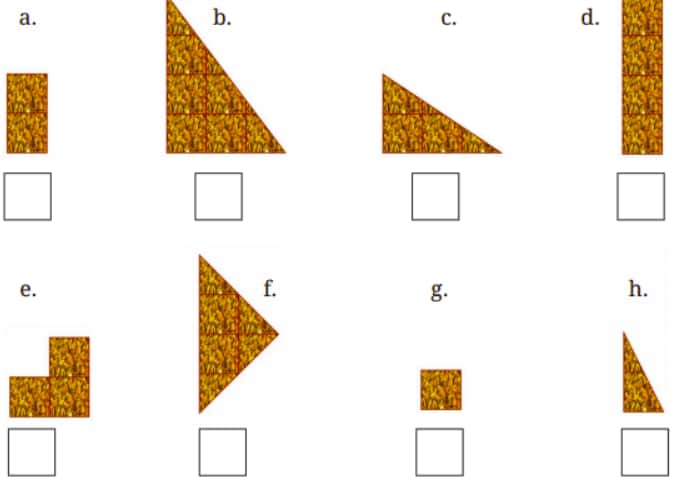
Answer:
a) We get this piece by breaking the chikki into 12 equal parts.
Hence, it is
b) We get this piece by breaking the chikki into 4 equal parts.
Hence, it is
c) We get this piece by breaking the chikki into 8 equal parts.
Hence, it is
d) We get this piece by breaking the chikki into 6 equal parts.
Hence, it is
e) We get this piece by breaking the chikki into 8 equal parts.
Hence, it is
f) We get this part by breaking the chikki into 6 equal pieces.
Hence, it is
g) We get this part by breaking the chikki into 24 equal pieces.
Hence, it is
h) We get this part by breaking the chikki into 24 equal pieces.
Hence, it is
|
Page number: 158 |
Question 1: Continue this table of

Answer:
Here, 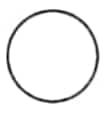 represents a full roti (whole)
represents a full roti (whole)
Step 1:

Step 2:
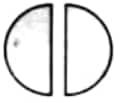
Step 3:
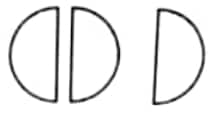
Step 4:

Step 5:
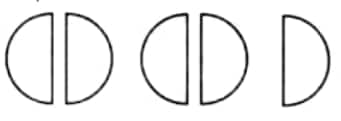
Step 6:

Step 7:

Question 2: Can you create a similar table for
Answer:
Yes, we can create a similar table for
Here

represents a full roti (whole).
|
| |
|
| |
|
| |
|
| |
|
| |
|
| |
|
| |
|
|
Question 3: Make
Answer: Yes, we can use this
Take a strip of paper.
Fold the strip into three equal parts and then open it up.
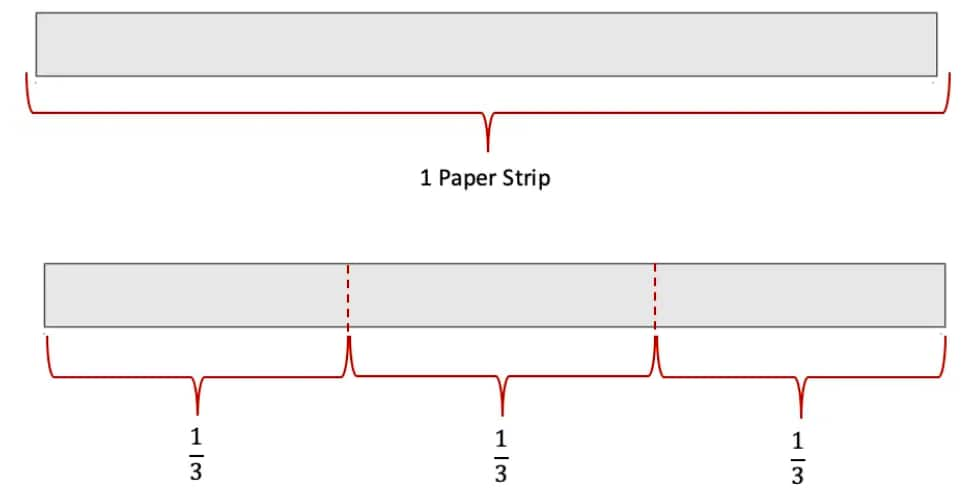
When we divide each part of this

Question 4: Draw a picture and write an addition statement as above to show:
a. 5 times
b. 9 times
Answer:
a)
5 times
Which means 1 full and
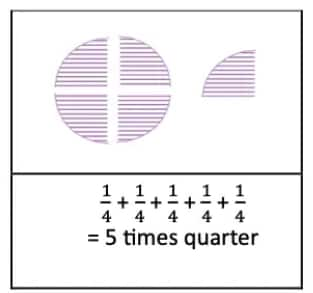
b)
9 times
Which means 2 full and
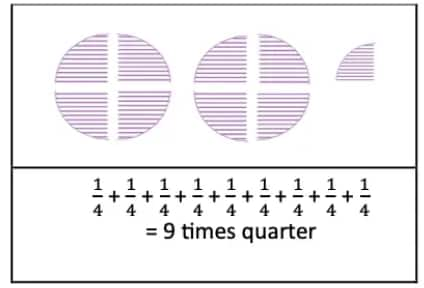
Question 5: Match each fractional unit with the correct picture:

Answer:
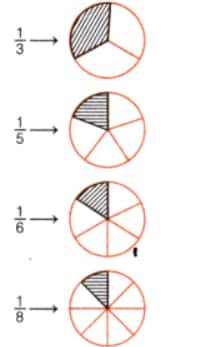
|
Page number: 160 |
Question 1: On a number line, draw lines of lengths
Answer:
Step 1. Draw a line I. Mark a point O on it.
Step 2. Mark point A at a distance of 1 unit from 0.
Step 3. Divide OA into 10 equal parts.
Here, OP represents

Question 2: Write five more fractions of your choice and mark them on the number line.
Answer:
Step 1. Let a number line OJ be divided into 10 equal parts.
Step 2. Now mark points A, B, C, D, ...., J on it.
Step 3. Here
OF represents
OG represents
OB represents
OH represents
Ol represents

Question 3: How many fractions lie between 0 and 1? Think, discuss with your classmates, and write your answer.
Answer: There are an infinite number of fractions between 0 and 1.
Example:
Question 4: What is the length of the blue line and black line shown below? The distance between 0 and 1 is 1 unit long, and it is divided into two equal parts. The length of each part is
Answer:
Length of black line is
Length of black line is
Fraction that gives length of black line

Question 5: Write the fraction that gives the lengths of the black lines in the respective boxes.

Answer:

|
Page number: 162 |
Question 1: How many whole units are there in
Answer:
Hence, 3 whole units are there in
Question 2: How many whole units are there in
Answer:
Here
Hence, 1 whole unit is there in
Hence, 2 whole units are therein
|
Page number: 162 |
Question 1: Figure out the number of whole units in each of the following fractions:
a.
b.
C.
Answer:
a) Numerator 8 is split/divided into as many 3 's, i.e., denominator number:
b)
Number of whole units
c)
Number of whole units
Question 2: Can all fractions greater than 1 be written as mixed numbers?
Answer: Yes, all fractions greater than 1 can be written as mixed fractions/numbers.
Question 3: Write the following fractions as mixed fractions (e.g.,
a.
b.
C.
d.
e.
f.
Answer:
(a)
(b)
(c)
(d)
(e)
(f)
|
Page number: 163 |
Question 1: Write the following mixed numbers as fractions:
a.
b.
c.
d.
e.
f.
Answer:
a) Here
b) Here
c) Here
d) Here
e) We have
(f)
|
Page number: 165 |
Question 1: Are
Answer: Here, simplest form of
Simplest form of
Simplest form of
Question 2: Write two equivalent fractions for
Answer: Here it is given
Hence
Question 3:
Answer:
|
Page number: 166 |
Question 1: Three rotis are shared equally by four children. Show the division in the picture and write a fraction for how much each child gets. Also, write the corresponding division facts, addition facts, and multiplication facts.
The fraction of roti each child gets is________.
Division fact:
Additional fact:
Multiplication fact:
Compare your picture and answers with your classmates!
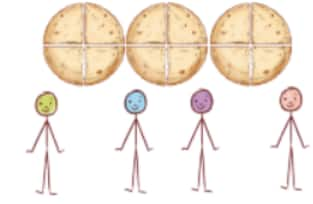
Answer:
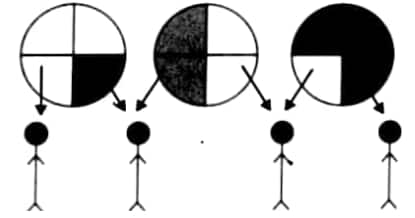
Division fact:
3 wholes divided into 4 parts
Addition fact:
Four times
Multiplication fact:
4 parts of
Question 2: Draw a picture to show how much each child gets when 2 rotis are shared equally by 4 children. Also, write the corresponding division facts, addition facts, and multiplication facts.
Answer:
As 2 rotis have to be shared equally by 4 children, we divide each roti into 4 parts and give
(a) 1 part of each roti to each child as shown below:
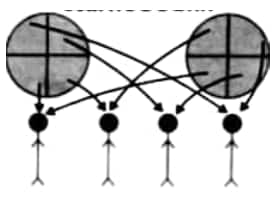
(b) 2 parts to each child as shown below
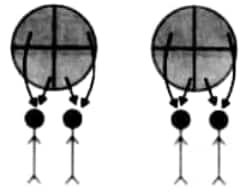
Question 3: Anil was in a group where 2 cakes were divided equally among 5 children. How much cake would Anil get?
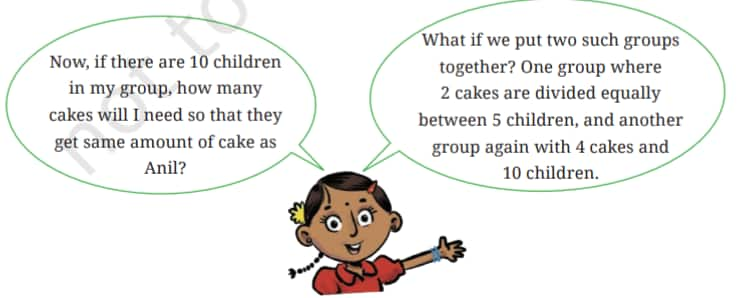
Answer: Anil is in a group where 2 cakes were divided equally among 5 children.
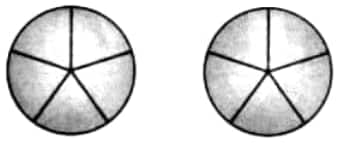
Each cake gets divided into 5 parts, and Anil gets one part from each cake, i.e.,
|
Page number: 168 |
Question: Find the missing numbers:
a) 5 glasses of juice shared equally among 4 friends is the same as _____ glasses of juice shared equally among 8 friends.
Answer:
Now to determine how many glasses of juice would be needed to give each of the 8 friends the same amount
So, 10 glasses of juice shared equally among 8 friends is the same as 5 glasses of juice shared equally among 4 friends.
b) Find the missing numbers: 4 kg of potatoes divided equally in 3 bags is the same as 12 kg of potatoes divided equally in _______ bags.
Answer: Let x be the number of bags for 12 kg of potatoes, where each bag has the same amount of potatoes, then
c) Find the missing numbers: 7 rotis divided among 5 children is the same as _______ rotis divided among ________ children.
Answer: Dividing 7 rotis among 4 children gives 7 each child
So, 7 rotis divided among 5 children is the same as 14 rotis divided among 10 children.
|
Page number: 173 |
Question: Express the following fractions in their lowest terms:
a.
b.
C.
d.
Answer:
a)
b)
c) Here,
[
d) Here, 525 and 112 are both multiples of 7 ; we divide both by 7 .
|
Page number: 174 |
Question 1: Compare the following fractions and justify your answers:
a.
b.
c.
d.
e.
Answer:
a. Given fractions are
Here LCM of the denominators 3 and 2 is 6.
Then, multiplying and dividing
b. Given fractions are
Here LCM of the denominators 9 and 7 is 63 .
then multiplying and dividing
then
Here,
c. Given fractions are
Here LCM of the denominators 10 and 14 is 70.
then multiplying and dividing
then
d. Given fractions are
Here, denominator is same so
e. Given fractions are
Here LCM of the denominators 4 and 2 is 4 . Then, multiplying and dividing
Question 2: Write the following fractions in ascending order.
a.
b.
Answer:
a)
LCM of 10,15 and
Now let us make the denominator of each fraction as LCM
Clearly
b) The given fractions are
Here LCM of
Thus
On arranging in ascending Order, we get
Question 3: Write the following fractions in descending order.
a.
b.
Answer:
a) LCM of
Now let us make the denominator of each fraction as LCM, thus
On arranging in descending order, we get
Hence, given fractions in descending order are
b) Here LCM of
Now let us make the denominator of each fraction as LCM, then
Hence, fractions in descending order are
|
Page number: 179 |
Question 1: Add the following fractions using Brahmagupta's method:
a.
b.
c.
d.
e.
f.
g.
h.
i.
j.
k.
l.
m.
Answer:
(a)
Given:
(b)
Here
Here, the LCM of the denominators 4 and 3 is 12
Hence,
(c)
(d)
Expressing as equivalent fractions with denominators 21, we get
(e)
(f)
Expressed as equivalent fractions with denominators 15, we get
(g)
(h)
(i)
(j)
Expressing as equivalent fractions with denominators 21(LCM), we get
(k)
Expressing as equivalent fractions with denominators
(l)
I) Expressing as equivalent fractions with denominators 105(LCM), we get
(m)
Expressing as equivalent fractions with denominators 12(LCM), we get
Question 2: Rahim mixes
Answer:
Given quantity of yellow paint
and quality of blue paint
Volume of green paint made
Here LCM of 3 and 4 is 12.
Now expressed as equivalent fractions with a denominator of 12, we get
Question 3: Geeta bought
Answer:
Given length of lace bought by Geeta
and length of lace bought by Shamim
Total length of lace
LCM of 5 and 4 is 20
Now expressed as equivalent fractions with a denominator of 20, we get,
Total lace required
Hence, the total lace Geeta and Shamim have together is sufficient to cover the whole border.
|
Page number: 181 |
Question 1:
Answer:
As fractional unit is same i.e.,
Then
Question 2:
Answer:
As fractional unit is same i.e.,
Question 3:
Answer: Here
|
Page number: 182 |
Question 1: Carry out the following subtractions using Brahmagupta's method:
a.
b.
c.
d.
Answer:
a) Given
Fractional unit for both fractions is
b) Given
Here LCM of 5 and 15 is 15. Fractional unit for both fractions should be
c) Given
Hence LCM of 6 and 9 is 18. Fractional unit for both fractions should be
Given
d) Given
Here LCM of 3 and 2 is 6 Fractional unit for both fractions should be
So,
Question 2: Subtract as indicated:
a.
b.
C.
Answer:
(a)
(b)
(c)
Question 3: Solve the following problems:
a. Jaya's school is
b. Jeevika takes
Answer:
a) Given distance between Jaya's school and home is
LCM of 10 and 2 is 10.
b) Time taken by Jeevika to cover 1 round of the park
To find who takes less time we need to compare
So, the time taken by Jevika and Namit will be
Clearly
Hence, Namit takes less time by
The topics discussed in the NCERT Solutions for class 6, chapter 7, Fractions, are:
Understanding fractions is learning to appreciate the beauty of parts within a whole. Here are some important notes that will help you to understand fractions better.
Fractions can be defined as a part of a whole. When one unit is divided into several equal parts, each part is called a fractional unit. The fractional units are
We usually read the fraction
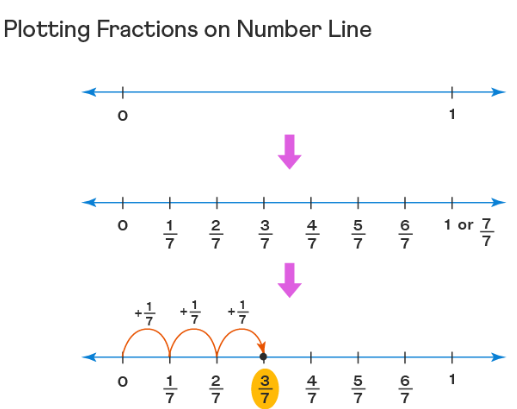
We can easily mark fractions on a number line. Here we mark numbers as 0 and 1 and divide them into 7 equal parts. So, starting from
These fractions are represented as a mix of 3 numbers instead of 2. They are improper fractions in which the numerator is bigger than the denominator, unlike the normal ones.
For example,
'Equivalent fractions' are those that denote the same length, but they are expressed in terms of different fractional units. For eg,
Fractions can be added and subtracted provided their denominator are the same. If not so, we take the LCM to make the denominators the same and then perform operations.
In the above case, the denominator is the same, so we have directly added the numerators. We must remember that neither in addition nor subtraction is the denominator added or subtracted.
Example:
In the above example, we notice that the denominators of both fractions are not the same. Hence, we take the LCM first and then multiply the numerator and denominator by the desired factor to finally add them.
In the above case, the denominator is the same, so we have directly subtracted the numerators.
If the denominators of both fractions are not the same. We take the LCM first and then multiply the numerator and denominator by the desired factor to finally subtract them.
Fractions: Fractions are numbers that are used to represent a part of the whole. For example,
Improper fractions: Improper fractions are fractions in which the numerator is greater than the denominator. Eg.
Mixed fractions: Mixed fractions are another form of improper fractions in the form
Equivalent Fractions: Equivalent fractions are fractions with the same value but different representations. Example:
Addition or Subtraction of Fractions: Addition and subtraction of fractions are possible only when the denominators are the same. For example,
If the denominators of the fractions to be added or subtracted are different, the LCM should be taken to make the denominators the same to add or subtract the fractions.
We at Careers360 compiled all the NCERT class 6 Maths solutions in one place for easy student reference. The following links will allow you to access them.
The NCERT Solutions provide the step-by-step solutions for all the questions in each chapter of the NCERT Book. To access subject-wise NCERT Solutions for Class 6, students can refer to the links below.
Students can also check the NCERT Books and the NCERT Syllabus for Class 6 here:

Take Aakash iACST and get instant scholarship on coaching programs.

This ebook serves as a valuable study guide for NEET 2025 exam.

This e-book offers NEET PYQ and serves as an indispensable NEET study material.

As per latest syllabus. Physics formulas, equations, & laws of class 11 & 12th chapters

As per latest syllabus. Chemistry formulas, equations, & laws of class 11 & 12th chapters
As per latest 2024 syllabus. Study 40% syllabus and score upto 100% marks in JEE